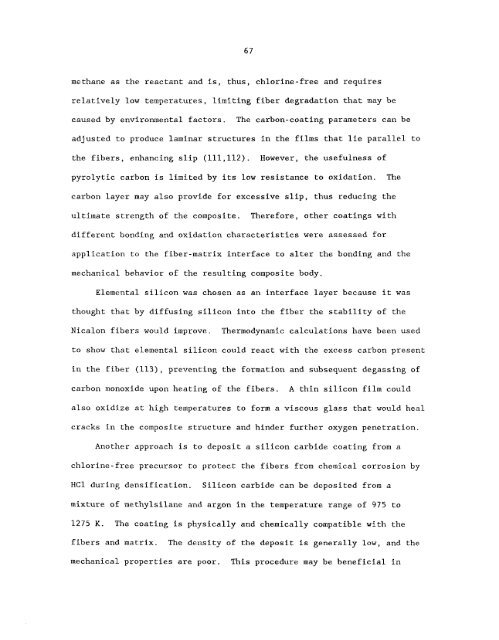Characterization and control of the fiber-matrix interface in ceramic ...
Characterization and control of the fiber-matrix interface in ceramic ...
Characterization and control of the fiber-matrix interface in ceramic ...
Create successful ePaper yourself
Turn your PDF publications into a flip-book with our unique Google optimized e-Paper software.
methane as <strong>the</strong> reactant <strong>and</strong> is, thus, chlor<strong>in</strong>e-free <strong>and</strong> requires<br />
relatively low temperatures, limit<strong>in</strong>g <strong>fiber</strong> degradation that may be<br />
caused by environmental factors. The carbon-coat<strong>in</strong>g parameters can be<br />
adjusted to produce lam<strong>in</strong>ar structures <strong>in</strong> <strong>the</strong> films that lie parallel to<br />
<strong>the</strong> <strong>fiber</strong>s, enhanc<strong>in</strong>g slip (111,112)* However, <strong>the</strong> usefulness <strong>of</strong><br />
pyrolytic carbon is limited by its low resistance to oxidation. The<br />
carbon layer may also provide for excessive slip, thus reduc<strong>in</strong>g <strong>the</strong><br />
ultimate strength <strong>of</strong> <strong>the</strong> composite. Therefore, o<strong>the</strong>r coat<strong>in</strong>gs with<br />
different bond<strong>in</strong>g <strong>and</strong> oxidation characteristics were assessed for<br />
application to <strong>the</strong> <strong>fiber</strong>-<strong>matrix</strong> <strong><strong>in</strong>terface</strong> to alter <strong>the</strong> bond<strong>in</strong>g <strong>and</strong> <strong>the</strong><br />
mechanical behavior <strong>of</strong> <strong>the</strong> result<strong>in</strong>g composite body.<br />
Elemental silicon was chosen as an <strong><strong>in</strong>terface</strong> layer because it was<br />
thought that by diffus<strong>in</strong>g silicon <strong>in</strong>to <strong>the</strong> <strong>fiber</strong> <strong>the</strong> stability <strong>of</strong> <strong>the</strong><br />
Nicalon <strong>fiber</strong>s would improve.<br />
Thermodynamic calculations have been used<br />
to show that elemental silicon could react with <strong>the</strong> excess carbon present<br />
<strong>in</strong> <strong>the</strong> <strong>fiber</strong> (113), prevent<strong>in</strong>g <strong>the</strong> formation <strong>and</strong> subsequent degass<strong>in</strong>g <strong>of</strong><br />
carbon monoxide upon heat<strong>in</strong>g <strong>of</strong> <strong>the</strong> <strong>fiber</strong>s.<br />
A th<strong>in</strong> silicon film could<br />
also oxidize at high temperatures to form a viscous glass that would heal<br />
cracks <strong>in</strong> <strong>the</strong> composite structure <strong>and</strong> h<strong>in</strong>der fur<strong>the</strong>r oxygen penetration.<br />
Ano<strong>the</strong>r approach is to deposit a silicon carbide coat<strong>in</strong>g from a<br />
chlor<strong>in</strong>e-free precursor to protect <strong>the</strong> <strong>fiber</strong>s from chemical corrosion by<br />
HC1 dur<strong>in</strong>g densification.<br />
Silicon carbide can be deposited from a<br />
mixture <strong>of</strong> methylsilane <strong>and</strong> argon <strong>in</strong> <strong>the</strong> temperature range <strong>of</strong> 975 to<br />
1275 K.<br />
The coat<strong>in</strong>g is physically <strong>and</strong> chemically compatible with <strong>the</strong><br />
<strong>fiber</strong>s <strong>and</strong> <strong>matrix</strong>.<br />
The density <strong>of</strong> <strong>the</strong> deposit is generally low, <strong>and</strong> <strong>the</strong><br />
mechanical properties are poor. This procedure may be beneficial <strong>in</strong>

















